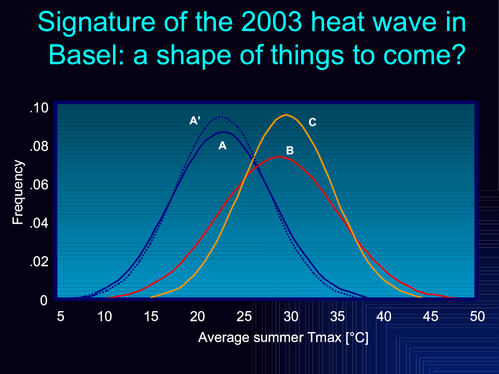

The record-breaking heat wave that affected much of Europe in the summer of 2003 was very different from the heat waves recorded in 1947 and 1976, and more like the conditions that might be expected towards the end of this century.M. Beniston and his team engaged in the EU project “PRUDENCE” used results from the HIRHAM regional climate model developed by the Danish Meteorological Institute for two 30-year simulations. The “current climate” simulation was run for the period from 1961 to 1990, while the “greenhouse-gas climate” simulation covered from 2071 to 2100. For both periods, M. Beniston studied the fluctuations in the daily maximum summer temperatures in Basel, Switzerland, a site that has long and high-quality climatic data (M. Beniston, 2004: Geophys. Res. Lett. 31 L02202) He then extended the model to different parts of Europe and found that in the latter half of this century, summer temperatures would increase across much of the continent leading to a “northward shift” in climatic zones. This implies that Switzerland could, by the end of this century, have a climate similar to that currently found in the South of France, i.e., a “Mediterranean-type” of climate with long, dry summers and a winter rainy season. Beniston observed a general increase of about 4-6°C in a band stretching across central Europe to the Black Sea, with greater increases over the Iberian Peninsula and the south west of France. In Basel, the 30°C threshold would be exceeded in the latter part of the century at least 40 days per year compared to less than 10 today. The summer period during which high temperatures could be expected is likely to be extended by 4 weeks or more compared to current climatic conditions, with the upper levels of summer maximum temperatures in the range of 38-45°C as compared to 30-35°C on average today. The 2003 heat wave, by mimicking quite closely the possible course of summers in the latter part of the 21st Century (see Figure), can thus be used within certain limits as an analog to what may occur with more regularity in the future. The severity of the impacts related to the persistence of elevated temperatures and drought conditions, in particular close to 15,000 excess deaths recorded in France, Italy and Spain, crop failures in many parts of the continent and strongly reduced river flow in much of western, central, and southern Europe, should be seen as a “shape of things to come” and should motivate both scientists in assessing the course of future climatic impacts and decision makers in formulating appropriate response strategies. |  Figure 1: Gaussian distributions fitted to the mean summer maximum temperature data at Basel, Switzerland, for the 1961-1990 reference period (A: Observations; A': HIRHAM4 model results), the 2071-2100 A2 scenario simulation (B) and the 2003 heat wave (C). This shows that the smoothed probability density function (PDF) for maximum temperatures in 2003 fits entirely within the PDF projected to occur in the latter part of the 21st century, and is well out of the range of the 1961-1990 summer maximum temperature PDF. |